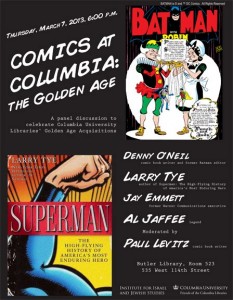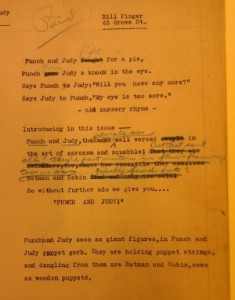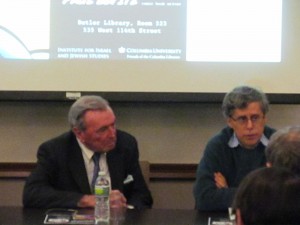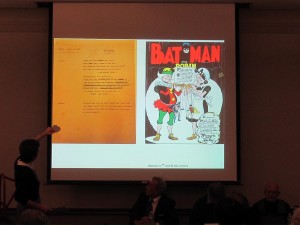On January 23rd, Columbia University Library acquired a double-bill of Golden Age related comics materials, including the research materials Larry Tye compiled to write his Superman biography, The High Flying History of America’s Most Enduring Hero, and six 1940’s BATMAN scripts from the estate of Jerry Robinson. These add to the ongoing Rare Book and Manuscript Collection at Columbia under the steerage of Graphic Novels Librarian Karen Green, already including Chris Claremont’s 2011 X-Men archive donation, and the large ELFQUEST bequest announced in early March. Columbia University, and a standing room only audience on March 7th, decided it was time to celebrate the donation, with a panel and reception entitled “Comics at Columbia: The Golden Age”, fortuitously coinciding with Will Eisner Week throughout the country.
The panel was moderated by Paul Levitz, educator, writer, and former president of DC Comics, and included Jay Emmet, former Warner Communications executive responsible for some of the first licensing of DC characters into toys and games, Denny O’Neil, former BATMAN editor and comic book writer, Al Jaffee, whose ongoing career as an artist on MAD Magazine can only be described as legendary, and Larry Tye, journalist and biographer, most recently of Superman.
Levitz introduced panelists who he hoped would help express the Golden Age of comics as “lived and seen” and trace the impact of the Golden Age into later comics history and his synopses of their careers pointed out that Emmet’s licensing of toys and action figures changed American childhood experience, O’Neil’s career sparked an era of “social consciousness” in comics, Jafee’s work introduced the tradition of “wiseass” humor into American comics, and that Tye has brought a level of “serious” journalism and biography to comics history by carefully engaging with all those whose lives have impinged on Superman’s development.
Levit’z general question to his panelists, “Why comics?” sparked a great deal of discussion as each member delved into their own pasts and tried to convey how they became drawn into comics as a career and what part comics have played in their lives. Jaffee supplied the historical context for comics just before World War II. At the “height of the depression”, he said, with “non-existent job prospects and anti-Semitism engulfing Europe”, he and many of his contemporaries found that the “old, established advertizing agencies” in New York would simply reject applications from those with Jewish names. Comics, on the other hand, Jaffee explained, were dominated by Jewish editors, artists, and writers, and beginning to flourish at that time. Since “comic book people were receptive”, Jaffee said, he and his contemporaries “jumped into it”, particularly since it was a paying gig.
Emmet was born into the comics industry, as the nephew of a Warner board member, and he spoke quite frankly about the “greed” and money-driven aspects of the industry that he perceived growing up. He reflected on his own role in getting lifetime sum of money for Siegel and Schuster, but from a merchandiser’s perspective, Emmet still felt that the lack of pay for the creators of Superman was negligible. Emmet’s most personal story, however, included a “sad story”, as Jaffee described it, of having an entire “silo” of comic books and pop culture memorabilia destroyed by his spring-cleaning wife who didn’t realize their emotional value to him. Needless to say, as the nephew of a Warner executive, Emmet had “every issue” of Golden Age comics in the destroyed collection.
O’Neil spoke about his work post Golden Age, handling many of the same characters. Levitz asked O’Neil why he felt characters like Superman and Batman have lasted so long, and are still relevant today. O’Neil’s eloquent response conveyed a great deal about his philosophy of comics creation. You have to “keep the essence of characters intact but let them evolve”, he explained, a lesson he learned from Julie Schwartz. It’s essential, O’Neil feels, to “let the character reflect what’s outside the window” to remain relevant, and it’s “those allowed to evolve who are still with us”, he concluded.
Levitz humorously pointed out that of the panelists, most “wandered into comics before frontal lobes were fully developed for judgment”, leaving them little choice but to pursue the medium, however, Tye’s position as a biographer returning to comics as subject matter was unique. Tye explained that the question of why Americans embrace the heroes that they do led him to write his biography of the Man of Steel. He, too, however, had a childhood connection to Superman, and loved working on the book for two years, feeling “10 years old” again.
Levitz asked individual panelists some specific questions about their areas of expertise, and started off by asking Emmet to explain just how DC licensing came about. Emmet explained that licensing was a new idea when he was a young publicist, and that he wanted to do “what hadn’t been done before”. Remarkably, his uncle tried to dissuade him from giving up a cushy job to pursue licensing, but Emmet proved predictions wrong by making astonishing sales in his first year of work by simply visiting and personally pitching DC character licensing to every toy company in New York. When Jaffee was asked to talk about daily life working for MAD as a young man, as many cartoonists today will find relatable, he said he simply spent all his time cartooning. Jaffee discussed one unique aspect of working for MAD that stood in contrast to working on superhero comics, that he could “use many characters” and had “freedom” since MAD was a “voracious consumer of material”, but that the pressure could be intense to come up with new ideas since “I was only as good as the next idea I had”.
O’Neill was asked to discuss how he managed to write over a 1000 BATMAN stories and still keep material fresh for readers. He admitted that he personally has a “low attention span” and is “bored easily” so tried to bring that reality to his work. He “set the rules” for himself early on with a 5 page document that spread to 35 pages of notes by the end of his career reminding him of guidelines to keep Batman’s universe on track. But after that, as an editor, the key was to hire “good creative people” and give them a “sense that what they are doing is not trash”, and then know, as an editor, when to “step back”. Imbuing creators with a sense that their work has some particular value to readers and fans formed one of the themes for the evening’s discussion. O’Neil memorably commented that while writing comics for him was a “job” and he was cognizant of the need to provide for his family, the “first death” of Robin, decided upon by reader-response phone-calls to “vote” on whether Robin would “survive”, was a wake up call for him about the significance of his work. Ordering food in a deli one day soon after Robin’s “death”, the owner heard he edited BATMAN and declared to the other customers that this was the guy who had “killed Robin”. Previous to that moment, O’Neil said, he had felt he was working in a “backwater” of publishing, but afterwards felt that he was, in fact, a “custodian of post industrial folklore” with deep meaning for readers. It was a sobering moment for him that conveyed a sense of “uncomfortable responsibility” and “enormous privilege”.
Tye, certainly, agreed with the value of comics as an art form and the essential role of preserving and archiving documents, explaining that two kinds of records are particularly important in preserving comics history, the written documents, such as those produced in the Siegel and Schuster law cases that shed light on the Golden Age of comics, and secondly, the documentation of oral histories from those involved in the early days of comics who are still living. All the panelists agreed that they hope soon Columbia Library will also be able to archive audio recordings of oral histories, and many of the scholars and professionals attending the event in the audience confirmed that they have recordings that might be useful for such an archive. In the age of digital files and increasingly easy transfer between older formats and digital files, why not? Karen Green agreed that it was a possibility for Columbia to attempt to preserve these files in the future as part of their comics-related collection.
Levitz’ final assessments about the contribution of his panelists to pop culture included Emmet’s role in “creating American childhood” through licensing, Jaffee’s pioneering persona in encouraging us to “question everything” through his work on MAD, and the social realities that O’Neil introduced and maintained in comics, as well as Tye’s invaluable contribution to uncovering the history of Superman as a cultural phenomenon. It was certainly an evening spent celebrating comics, and in particular, a time to look back on the seminal periods in the development of comics that were directed in their development by true pioneers. What better way to dignify the impact of comics than to preserve their original documents for future study and appreciation? Collecting and archiving comics materials at Columbia has quickly moved from a new program to a steady stream of worthy additions, and the panel celebration suggested increasing momentum in preserving comics history at Columbia.
Hannah Means-Shannon writes and blogs about comics for TRIP CITY and Sequart.org and is currently working on books about Neil Gaiman and Alan Moore for Sequart. She is @hannahmenzies on Twitter and hannahmenziesblog on WordPress.











What a terrific and thorough overview, Hannah–thanks! And thanks to the 70+ people who turned out for the evening and helped our stellar panelists make it such a wonderful evening!